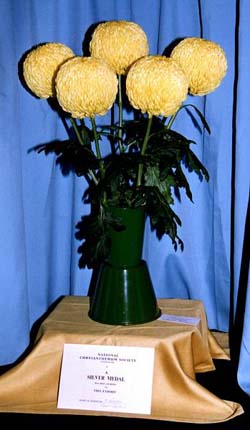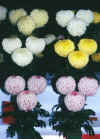This article was originally published on the web on chrysanthemums.info however that website is defunct at February 2020. The copyright is with the original owners of chrysanthemums.info and the article is reproduced here as it is informative.
Staging blooms for exhibition
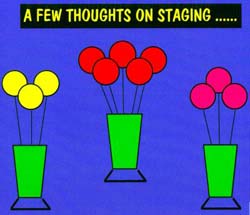 Good blooms that are well staged will take some beating on the show bench. Chrysanthemums are usually exhibited either one, three or five blooms/stems in each vase.
Good blooms that are well staged will take some beating on the show bench. Chrysanthemums are usually exhibited either one, three or five blooms/stems in each vase.
Three blooms per vase
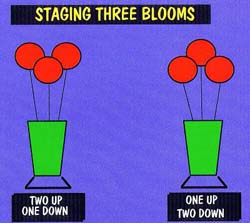 When staging 5 blooms there's no choice about how we position the blooms - 3 at the back and two in front. With 3s we have two choices, what I call 'two up and one down', and '1 up and 2 down'. There are definitely times when one style can be used in preference to the other. For instance, with one bloom larger than the other two I would put this one at the back and the two smaller blooms lower at the front, the reverse is true if one bloom is smaller than the other two. When all blooms are uniform in size the we have a choice how to place the blooms in the vase.
When staging 5 blooms there's no choice about how we position the blooms - 3 at the back and two in front. With 3s we have two choices, what I call 'two up and one down', and '1 up and 2 down'. There are definitely times when one style can be used in preference to the other. For instance, with one bloom larger than the other two I would put this one at the back and the two smaller blooms lower at the front, the reverse is true if one bloom is smaller than the other two. When all blooms are uniform in size the we have a choice how to place the blooms in the vase.
Staging six vases of three
Five blooms per vase
Staging 3 vases of 5 is probably the most common multivase entry for most of us. I like to be able to view my entry from the side if possible, and this is what I'm looking for.
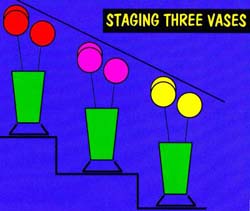 I try to imagine a straight line as shown on the diagram. You might think this is an obvious outcome after staging the three vases, but it's not always the case. When the staging is not uniform - in other words the drop between top row and middle and middle row and bottom is not the same it will be necessary to stage at slightly different heights in order to get the exhibit to look right. This does mean deciding in advance the order that the vases will be staged.
I try to imagine a straight line as shown on the diagram. You might think this is an obvious outcome after staging the three vases, but it's not always the case. When the staging is not uniform - in other words the drop between top row and middle and middle row and bottom is not the same it will be necessary to stage at slightly different heights in order to get the exhibit to look right. This does mean deciding in advance the order that the vases will be staged.
Positioning blooms in the vase
With 5's I like to see the back row as a gentle curve, the centre bloom an inch or so higher than the two side blooms, this is why cutting all blooms to the same height is important. In most cases, with mediums at least, without any further trimming the natural splay of the vase will ensure that the two side blooms fall nicely below the height of the upright centre bloom. It doesn't always work but in the majority of cases it works out just right.
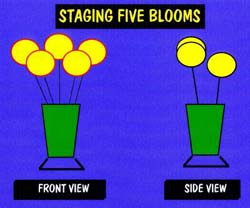 The front two blooms are staged lower again, sufficiently low to expose about three quarters of the back blooms. The blooms being spaced such that the stem of the centre back bloom is visible and the back bloom itself is centrally positioned above and between the two lower blooms. I like to see for a gentle slope from back row to front row - not a step down caused by significant differences in heights . Front blooms which are too high such that they obscure the back blooms is equally as bad.
The front two blooms are staged lower again, sufficiently low to expose about three quarters of the back blooms. The blooms being spaced such that the stem of the centre back bloom is visible and the back bloom itself is centrally positioned above and between the two lower blooms. I like to see for a gentle slope from back row to front row - not a step down caused by significant differences in heights . Front blooms which are too high such that they obscure the back blooms is equally as bad.
In this example the staging isn't too bad. Front blooms could possibly be a little lower.
Best Vase Incurved
N.C.S. Early National 1991
